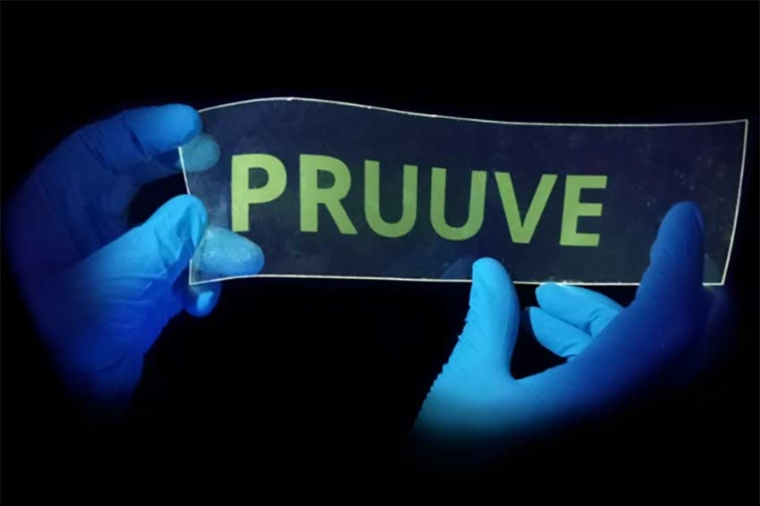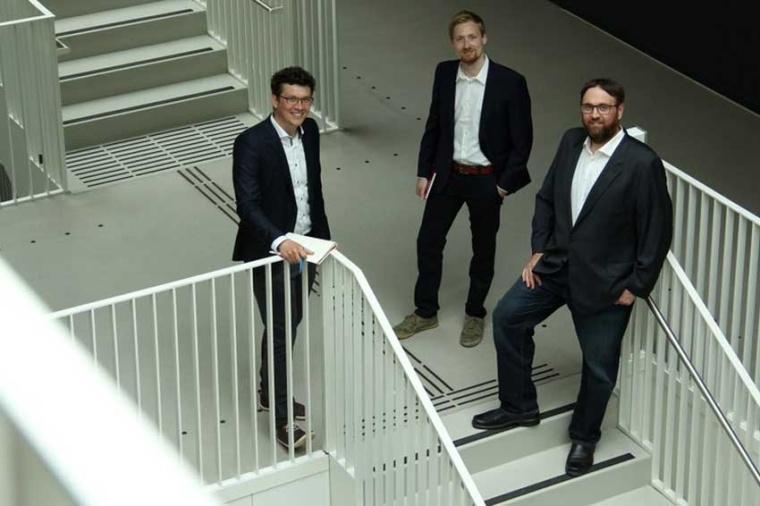Reusable UV sensor films
Through a spin-off, three Dresden physicists want to bring UV curing and UV disinfection technology to market in the next 18 months.
Artificially generated UV radiation is used in numerous industrial applications: for example, for the sterilization of air, water, and surfaces or for the rapid curing of coated surfaces, printing inks, paints or adhesives. However, quality and success control in the use of UV radiation still has a great deal of room for improvement, especially with regard to the accurate measurement of the UV dose. If, for example, a too low UV dose is used in offset printing, entire batches of product have to be discarded because the coating is not dry. Surface disinfection, on the other hand, can leave behind harmful viruses or bacteria. Therefore, overdosing is often used, resulting in high operating costs and premature maintenance.


“Our UV sensor films enable accurate measurement of the UV dose for the first time directly on the surface and during the manufacturing process,” says Dr Paul-Anton Will, co-founder and responsible for product development at Pruuve. “We offer a reliable and fast control of success in UV curing and UV disinfection. Companies can thus avoid unnecessary waiting times, reduce their energy costs and also reduce material wear.” In the future, the technology will also be used in other products, for example as reusable labels or in security applications.
The physical principle behind it was discovered and further developed in 2018 in the laboratories of the Dresden Integrated Center for Applied Physics and Photonic Materials IAPP and the Institute of Applied Physics by Prof Sebastian Reineke and his team. “We use ultrathin films coated with phosphorescent organic molecules. When the molecules are excited by irradiation with UV light, they begin to glow,” Will explains. “The special feature here is that we can control exactly at which irradiated UV dose the phosphorescence appears by layer composition.”
Through a spin-off, the three physicists Tim Achenbach, Dr Paul-Anton Will and Dr Philipp Wellmann want to bring the technology to market in the next 18 months. To this end, the team has been receiving EXIST research transfer funding of around 790,000 euros since May 1, 2022. With the EXIST program, the German Federal Ministry of Economics and Climate Protection supports outstanding, research-based start-up projects. The scientists found advice and support with the application process at Dresden Exists, the startup service of Dresden’s universities and research institutions. In their own Venture Acceleration Program, the consultants will continue to support the team until the foundation of the company.
The founding team brings not only technological knowledge but also entrepreneurial experience to the table: Tim Achenbach is the scientist in the team and drives the technological development. Dr Will is responsible for customer-oriented product development and production. Dr Wellmann contributes his network and experience as managing director and sales manager in the areas of R&D and marketing / sales. Prof Reineke continues to accompany the project as scientific mentor and advisor.
The team is currently looking for reinforcement in the areas of technology, laboratory and sample production.
Company
Technische Universität DresdenGeorge-Bähr-Str. 1-3
01069 Dresden
Germany
most read

Teledyne Vision Solutions: Camera manufacturer unifies machine vision portfolio
Teledyne combines the various machine vision technologies, including 1D, 2D and 3D cameras, under the umbrella of "Teledyne Vision Solutions".

First access for external users to the QSolid quantum computer
The prototype of the QSolid quantum computer was successfully integrated into the JUNIQ infrastructure of the Jülich Supercomputing Center.

Otto wins IERA Award 2025
Rockwell's robot is an AMR solution that can transport heavy loads in factories and operate in robot fleets of over 100 units.

Qioptiq Photonics becomes Excelitas Germany
The renaming is part of the global consolidation of the Excelitas Group.

Successful conclusion of the IVSM Fall Meeting 2025 in Haikou, China
The 2025 Autumn International Vision Standards Meeting (IVSM) took place from November 3 to 7 in Haikou, Hainan, and attracted over 120 R&D engineers worldwide.






